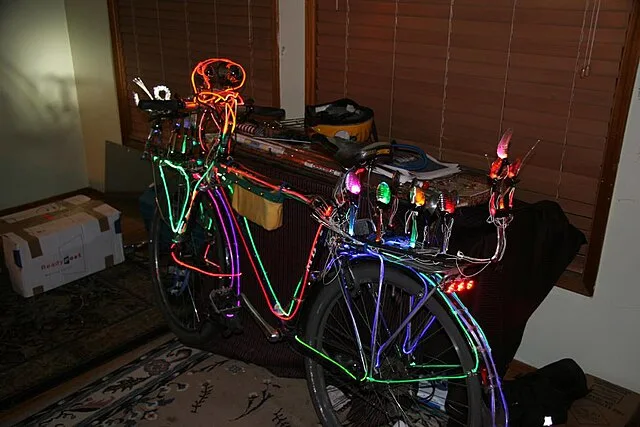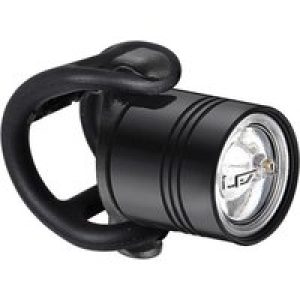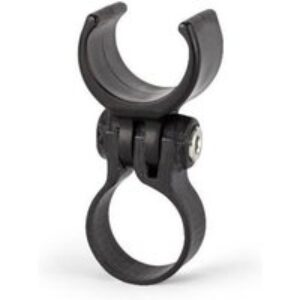
Particularly when you’re new to cycling, you might be wondering are bike lights a legal requirement in the UK?
The use of bike lights is not merely a recommendation for cyclists, it’s a legal requirement designed to ensure the safety of cyclists and other road users during hours of darkness or low visibility. According to the UK’s Highway Code and the Road Vehicles Lighting Regulations (RVLR), all bicycles used on public roads during the hours of darkness must be equipped with properly functioning lights and reflectors. Specifically, from sunset to sunrise, bicycles must have a white light visible from the front and a red light visible from the rear. Additionally, bikes must have a red rear reflector and amber pedal reflectors on both the front and rear of each pedal to enhance visibility to other road users.
The legislation is clear on the minimum requirements, but it also allows for additional lights and reflectors provided they comply with the regulations. (The bike in the pic above may even be ok!) This legal framework ensures that cyclists are visible to motorists, pedestrians, and other cyclists, reducing the risk of accidents and enhancing overall road safety.
Can Bike Lights Be Too Bright?
While the law requires the use of bike lights for visibility, there’s growing concern among road users about the potential for bike lights to be excessively bright, causing dazzle and posing a risk to oncoming traffic. Although the UK law does not specify a maximum brightness level for bike lights, it implies that lights should not dazzle other road users. The brightness of bike lights is measured in lumens – some models available on the market can reach levels of brightness comparable to car headlights!
Cyclists are advised to use their lights responsibly, especially when using high-lumen lights in built-up areas or when facing oncoming traffic. Positioning the light correctly, so it’s angled slightly downwards, can minimise the risk of temporarily blinding others while still ensuring the cyclist is visible. It’s a matter of balancing safety and courtesy; ensuring visibility without compromising the safety of others.
How Bright Should Bike Lights Be?
The appropriate brightness for bike lights depends on the cycling environment. For urban areas with well-lit streets, a front light with an output of around 100 lumens may be sufficient to make a cyclist visible to others. However, for darker conditions or rural areas with little to no street lighting, a brighter light of 300 lumens or more may be necessary to adequately illuminate the path ahead and ensure the cyclist’s visibility to oncoming traffic.
It’s important for cyclists to consider the type of light they use as well. Lights can be categorised as ‘be seen’ lights, which ensure others can see you, and ‘see with’ lights, which help you see the road in dark conditions. For the rear light, a brightness of around 40 to 100 lumens is generally considered adequate for most conditions.
In the end, you should choose a light that provides enough visibility without being excessively bright for the conditions. It’s just about using common sense and you should adjust the brightness and direction of the lights based on your environment to ensure they are visible without endangering other road users.
So, now you can enjoy your night-time rides and know you’re within the law!
Here’s a selection of bike light offers to suit all budgets:
-
Product on sale
 £12.00 – Lezyne Femto Drive LED Front Light£12.00
£12.00 – Lezyne Femto Drive LED Front Light£12.00 -
Product on sale
 £13.50 – Exposure Aero Extension Bracket for Helmet Lights£13.50
£13.50 – Exposure Aero Extension Bracket for Helmet Lights£13.50 -
Product on sale
 £19.99 – Cateye AMPP 200 Front Bike Light£19.99
£19.99 – Cateye AMPP 200 Front Bike Light£19.99 -
Product on sale
 £16.99 – Cateye Tight Kinetic Rear Brake Bike Light£16.99
£16.99 – Cateye Tight Kinetic Rear Brake Bike Light£16.99 -
Product on sale
 £3.59 – Ravemen AUB01 Upside-Down Bracket Go Pro£3.59
£3.59 – Ravemen AUB01 Upside-Down Bracket Go Pro£3.59 -
Product on sale
 £3.59 – Ravemen ABM07 Saddle Rail Mount For Rear Light£3.59
£3.59 – Ravemen ABM07 Saddle Rail Mount For Rear Light£3.59